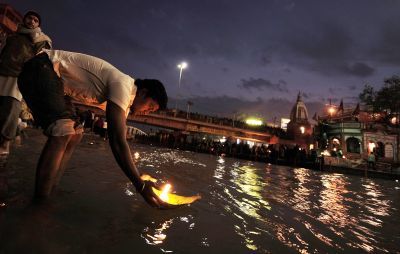Largest religious festival on Earth under way in India

Hundreds of thousands of Hindu devotees took a ritual bath in India's holy Ganges river before daybreak Thursday as the world's largest religious gathering got under way.
Braving chilly weather, hordes of pilgrims rose before sunrise in and around the northern town of Haridwar and made their way in darkness to the banks of the river to immerse themselves in the sacred waters.
They have come from all over India: families and couples, wealthy and poor, businessmen and farmhands, and itinerant "sadhus" (holy men) draped in saffron-coloured robes.
Smaller bathing rituals were held along the entire length of the Ganges.
In the eastern state of West Bengal, seven pilgrims, including one child, were crushed to death in a stampede when hundreds of devotees rushed for places on a ferry to take them to a bathing site on Gangasagar island - where the Ganges flows into the Bay of Bengal.
For Hindu devotees, the three-month Kumbh Mela festival offers them the chance to wash away their sins and break the karmic cycle of life and rebirth.
Even in a country where mass events are commonplace, the sheer size of the Kumbh Mela sets it apart.
Several million people were set to take part Thursday on the first of four particularly auspicious bathing dates, with millions more expected to pass through the sprawling festival encampment in Haridwar over the next 12 weeks.
"Your soul will be cleansed and you will be free from disease if you take such a bath during this period," Sushant Raj, a professional astrologist, said as he emerged from his own dip.
"The water is cleaner and has more natural power in the early morning," he added.
Women clustered on the final step of the "ghats" leading down to the river, unravelling their saris in the cold weather and using copper bowls to collect the water and pour it over their heads and torsos.
As the sun rose, many stepped further into the river, immersing their entire bodies.
One woman in a bright red sari followed her ablutions by throwing necklaces of bright marigolds into the river where they were taken downstream by the current.
"The water was really cold," said Bhawna Agri, 14, who travelled with her family from the neighbouring state of Uttar Pradesh to attend her first Kumbh Mela.
"I only washed my hair and face and I'm still freezing," she said, shivering on the ghat steps.
The festival commemorates a mythical battle between gods and demons over a pitcher of the nectar of immortality.
During the struggle, a few drops of nectar fell in four different places: Allahabad, in the state of Uttar Pradesh, Haridwar in Uttarakhand, Ujjain in Madhya Pradesh and Nasik in Maharashtra.
The Kumbh Mela alternates between these four places and takes place every three years. Once every 12 years, an even larger Maha Kumbh Mela is held. The next will be in Allahabad in 2013.
The triennial festival also marks the only public gathering of hundreds of Naga sadhus, who otherwise live in relative isolation in mountains, caves and communes in the Himalayas and other regions of India.
Naked and generally covered in a layer of grey ash, they are regarded by devotees as earthly representatives of the gods because of their self-sacrifice and denial of the material world.
The Nagas, carrying ritual swords and tridents, will lead ceremonies on the most auspicious bathing day of all on April 14 when the Mela draws to a close.
Soham Baba, considered the leader of the Nagas, told reporters recently in Kolkata that they planned to use the 2010 Kumbh Mela to highlight the issue of global warming.
"Sadhus like us who go up to the higher reaches of the Himalayas to meditate have a clear picture of how bad the situation is," he said.
"Pristine lakes and waterfalls that existed till a few years ago have dried up."
Over the years, the festival has also become something of a tourist attraction, drawing foreigners who sometimes come to participate or simply witness the spectacle of so many people gathering for a common purpose.
"It's amazing and it's crazy. You can really feel the energy," said Marco Necher, a retiree and amateur photographer from Liechtenstein.
Subscribe to Independent Premium to bookmark this article
Want to bookmark your favourite articles and stories to read or reference later? Start your Independent Premium subscription today.

Join our commenting forum
Join thought-provoking conversations, follow other Independent readers and see their replies